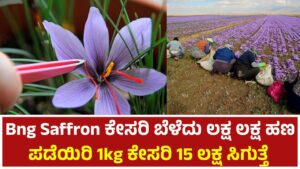Bng Saffron ಕೇಸರಿ ಬೆಳೆದು ಲಕ್ಷ ಲಕ್ಷ ಹಣ ಪಡೆಯಿರಿ 1kg ಕೇಸರಿ 15 ಲಕ್ಷ ಸಿಗುತ್ತೆ
Introduction to Saffron
Saffron, known as the “golden spice,” is derived from the stigmas of the Crocus sativus flower. Revered for its culinary, medicinal, and cosmetic applications, saffron is prized worldwide for its vibrant color, unique aroma, and distinct taste. It is the most expensive spice globally due to its labor-intensive harvesting process, which requires thousands of flowers to produce a small quantity of saffron threads.

- Cultural Significance: Saffron has been used for centuries in cuisines, rituals, and traditional medicine across Asia, the Middle East, and Europe.
- Economic Importance: Growing saffron offers a lucrative opportunity for small and large-scale farmers due to its high market value.
Understanding Saffron Cultivation
Climate Requirements
Saffron thrives in regions with a Mediterranean climate:
- Temperature: Saffron requires cool winters and hot, dry summers. Ideal temperature ranges from 15°C to 35°C.
- Rainfall: Moderate rainfall is suitable, but the crop is sensitive to waterlogging.
- Altitude: Grows best at altitudes between 1,500 and 2,500 meters above sea level.
Soil Requirements
- Soil Type: Well-drained sandy or loamy soil is ideal for saffron.
- pH Level: Slightly alkaline soil (pH 6.0–8.0) promotes healthy growth.
- Drainage: Excess water can rot the corms, so soil with good drainage is crucial.
Land Preparation
Site Selection
Choose a plot with:
- Ample sunlight exposure.
- Protection from strong winds.
- Good irrigation systems to avoid water stagnation.
Soil Preparation
- Plowing and Leveling: Deep plow the soil to a depth of 30–40 cm to aerate it.
- Fertilization: Incorporate organic compost or manure to enrich the soil.
- Weeding: Remove all weeds to reduce competition for nutrients.
Saffron Corms (Bulbs)
Choosing Quality Corms
- Purchase healthy, disease-free corms from reputable suppliers.
- Corms should be firm, large (weighing 10–15 grams), and free from cuts or bruises.
Storing Corms
- Store corms in a cool, dry place with good ventilation until planting.
- Avoid exposure to direct sunlight or moisture.
Planting Saffron
When to Plant
- Planting Season: Late summer to early autumn (August–September) is the best time for planting saffron.
How to Plant
- Spacing: Plant corms 10–15 cm apart in rows spaced 20–25 cm apart.
- Depth: Place corms 7–10 cm deep in the soil.
- Orientation: Ensure the pointed end faces upward.
Irrigation After Planting
- Water lightly after planting to encourage root development.
- Avoid overwatering, especially during the dormant phase.
Saffron Growth Stages
Germination
- Occurs within 15–20 days after planting.
- Green shoots emerge from the soil.
Flowering
- Begins 6–8 weeks after planting.
- Flowers bloom for 2–3 weeks, usually in late October to November.
Dormancy
- After flowering, the plant enters a dormant phase during spring and summer.
- Leaves wither, but corms remain alive underground.
Caring for Saffron Plants
Watering
- Saffron requires minimal water.
- Irrigate only during flowering and dry periods.
Fertilization
- Apply organic fertilizers, such as compost or cow manure, once a year during planting.
Weeding
- Regularly remove weeds to prevent nutrient competition.
- Use hand weeding or light tools to avoid damaging corms.
Pest and Disease Management
- Pests: Rodents and aphids can harm saffron. Use natural repellents or traps.
- Diseases: Fusarium rot and corm blight are common issues. Ensure good drainage and rotate crops to minimize risks.
Harvesting Saffron
Timing
- Harvest flowers early in the morning when blooms are fresh.
- Flowers usually bloom for just one day.
Harvesting Process
- Pluck the entire flower gently by hand.
- Extract the red stigmas (saffron threads) from each flower.
- Avoid damaging the delicate threads during the process.
Post-Harvest Processing
Drying
- Lay the stigmas on a clean surface in a single layer.
- Dry them under shade or use a dehydrator at 30–35°C for faster results.
- Ensure threads are crispy but not burnt.
Storage
- Store dried saffron in an airtight container away from light and moisture.
- Properly stored saffron can retain its quality for up to 2–3 years.
Economics of Saffron Cultivation
Costs
- Initial costs include corms, fertilizers, and labor.
- Annual maintenance costs are minimal compared to the high value of the yield.
Yield
- One hectare of land can produce 15–25 kilograms of dried saffron annually.
- Prices range between $1,500–$3,000 per kilogram, depending on quality.
Marketing Saffron
Local Markets
- Sell saffron to local spice merchants or directly to consumers.
Export Opportunities
- Countries like Spain, Iran, and India export saffron globally.
- Focus on premium packaging and certifications to meet international standards.
Value Addition
- Create saffron-based products, such as teas, cosmetics, or culinary kits.
Challenges in Saffron Farming
Environmental Risks
- Frost during flowering can damage crops.
- Prolonged rains may lead to corm rot.
Labor Intensive
- Manual harvesting and processing require skilled labor.
High Initial Investment
- Quality corms are expensive, but the long-term benefits outweigh the costs.
Sustainable Saffron Farming
Organic Practices
- Use natural fertilizers and pest repellents.
- Avoid synthetic chemicals to maintain soil health.
Intercropping
- Grow saffron alongside other low-water crops like lavender to optimize land use.
Conclusion
Growing saffron is a rewarding endeavor that requires patience, dedication, and careful planning. By understanding the crop’s specific needs and following best practices, farmers can achieve high-quality yields and reap significant economic benefits.
This guide provides a comprehensive roadmap for anyone looking to venture into saffron cultivation, ensuring long-term success and sustainability.
